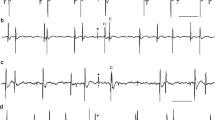Summary
In cat medial gastrocnemius motoneurons, single stimuli to the cutaneous sural nerve evoke a post-synaptic potential with a mixture of depolarization and hyperpolarization, depolarization being dominant in type F cells and hyperpolarization in type S cells. This pattern is consistent with previous reports showing that activation of the sural nerve can sometimes reverse the normal order of motor unit recruitment by inhibiting S motor units while simultaneously exciting F motor units. However, during repetitive stimulation for 1–2 s, we found that the hyperpolarizing component of the sural input to medial gastrocnemius motoneurons was not persistent, but instead gave way to depolarization after the first 30 ms. The net steady-state response after 0.5–1.0 s of stimulation was depolarization in all cells, regardless of motor unit type. This suggests that tonic sural input may be incapable of producing prolonged recruitment reversals.
Similar content being viewed by others
References
Baldissera F, Hultborn H, Illert M (1981) Integration in spinal neuronal systems. In: Brooks V (eds) Handbook of physiology, sect 1, The nervous system, vol II, motor control, part 1. American Physiological Society, Bethesda, pp 509–595
Burke RE (1981) Motor units: anatomy, physiology, and functional organization. In: Brooks V (eds) Handbook of physiology, sect 1, The nervous system, vol II, motor control, part 1. American Physiological Society, Bethesda, pp 345–422
Burke RE, Jankowska E, ten Bruggencate GA (1970) Comparison of peripheral and rubrospinal synaptic input to slow and fast twitch motor units of triceps surae. J Physiol (Lond) 207:709–732
Cope TC, Clark BD (1991) Motor-unit recruitment in the decerebrate cat: several unit properties are equally good predictors of order. J Neurophysiol 66:1127–1138
Collins WF, Honig MG, Mendell LM (1984) Heterogeneity of group Ia synapses on homonymous alpha-motoneurons as revealed by high frequency stimulation of Ia afferent fibers. J Neurophysiol 52:980–993
Gustafsson B, Pinter MJ (1985) On factors determining orderly recruitment of motor units: a role for intrinsic membrane properties. Trends Neurosci 8:431–433
Heckman CJ, Binder MD (1988) Analysis of effective synaptic currents generated by homonymous Ia afferent fibers in motoneurons of the cat. J Neurophysiol 60:1946–1966
Heckman CJ, Binder MD (1990) Neural mechanisms underlying the orderly recruitment of motoneurons. In: Binder M, Mendell L (eds) The segmental motor system. Oxford University Press, New York, pp 182–204
Henneman E, Mendell LM (1981) Functional organization of motoneuron pool and its inputs. In: Brooks V (eds) Handbook of physiology, sect 1, The nervous system, vol II, motor control, part 1. American Physiological Society, Bethesda, pp 423–507
Hounsgaard J, Hultborn H, Jespersen B, Kiehn O (1988) Bistability of α-motoneurones in the decerebrate cat and in the acute spinal cat after intravenous 5-hydroxytryptophan. J Physiol (Lond) 405:345–367
Kanda K, Burke RE, Walmsley B (1977) Differential control of fast and slow twitch motor units in the decerebrate cat. Exp Brain Res 29:57–74
Labella L, Kehler J, McCrea DA (1989) A differential synaptic input to the motor nuclei of triceps surae from the caudal and lateral cutaneous sural nerves. J Neurophysiol 61:291–301
Powers RK, Binder MD (1985) Distribution of oligosynaptic group I input to the cat medial gastrocnemius motoneuron pool. J Neurophysiol 53:497–517
Rudomin P (1990) Presynaptic control of synaptic effectiveness of muscle spindle and tendon organ afferents in the mammalian spinal cord. In: Binder M, Mendell L (eds) The segmental motor system. Oxford University Press, New York, pp 349–380
Vander Maelen CP, Aghajanian GK (1982) Serotonin-induced depolarization of rat facial motoneurons in vivo: comparison with amino acid transmitters. Brain Res 239:139–152
Zengel JE, Reid SA, Sypert GW, Munson JB (1985) Membrane electrical properties and prediction of motor-unit type of medial gastrocnemius motoneurons in the cat. J Neurophysiol 53:1323–1344
Zytnicki D, Lafleur J, Horcholle-Bossavit G, Lamy F, Jami L (1990) Reduction of Ib autogenetic inhibition in motoneurons during contractions of an extensor muscle in the cat. J Neurophysiol 64:1380–1389
Author information
Authors and Affiliations
Rights and permissions
About this article
Cite this article
Heckman, C.J., Miller, J.F., Munson, M. et al. Differences between steady-state and transient post-synaptic potentials elicited by stimulation of the sural nerve. Exp Brain Res 91, 167–170 (1992). https://doi.org/10.1007/BF00230025
Received:
Accepted:
Issue Date:
DOI: https://doi.org/10.1007/BF00230025




